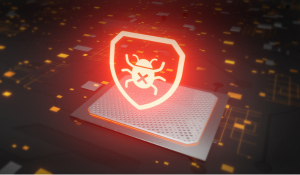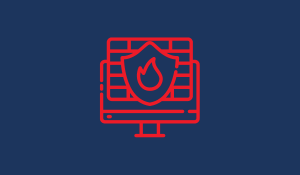Indicators of Compromise (IoCs): The early warning signs of a cyber attack
Cyber threats are evolving rapidly. For organizations in healthcare, manufacturing and critical infrastructure, it is crucial to remain vigilant....

The threat situation in cyberspace is constantly evolving. New attack vectors, techniques and vulnerabilities emerge every day. It is therefore crucial for IT specialists to maintain an overview in order to be able to act proactively. Threat intelligence is the tool that transforms information into actionable knowledge.
| TABLE OF CONTENT |
It's about identifying, analyzing and understanding threats before they can cause damage. In this article, you'll learn what threat intelligence is, how it works and why it's essential for your organization.
An organization that is in the dark can do little to protect itself from threats. Information about potential threats is the key to a robust defense. Threat intelligence collects, processes and analyzes data about cyber threats. The aim is to identify patterns, tactics and motivations of attackers. Not only technical indicators such as IP addresses or malware signatures are taken into account, but also strategic information about the attackers. These findings help to eliminate vulnerabilities and optimize defence strategies before an attack even takes place.
Effective threat intelligence follows a clear process to extract useful insights from raw data. This cycle ensures that the information is current, relevant and actionable. The process starts with planning and ends with feedback that continuously improves the cycle. A systematic approach ensures that threat intelligence is not just a one-off activity, but an ongoing improvement to the security posture.
Planning and requirements: Define your organization's information needs. Which assets need to be protected? Which threats are relevant (e.g. ransomware, APTs)?
Data collection: Gather raw data from various sources such as open source information (OSINT), technical data feeds, dark web forums and internal system logs.
Processing and analysis: Structure and analyze the collected data. Filter out irrelevant information and identify patterns and correlations.
Production: Create reports and alerts based on the analysis that are relevant for the relevant teams (e.g. SOC, management).
Dissemination and integration: Distribute the final findings to the relevant stakeholders and integrate them into your organization's security tools and processes (e.g. SIEM, firewalls).
Feedback: Collect feedback from threat intelligence users to optimize the process and improve the quality of the results.
Not all threat intelligence is the same. There are different levels of threat intelligence depending on the target group and area of application. These different types of threat intelligence are aimed at different decision-makers within an organization. While the technical level is important for security teams, executives need a strategic perspective to make informed decisions. The combination of all levels enables a holistic defense.
Strategic Threat Intelligence: This type is aimed at managers and decision-makers. It provides a broad overview of the global threat landscape, sheds light on the motives of attackers and helps to plan the organization's long-term security strategy.
Tactical Threat Intelligence: This focuses on the tactics, techniques and procedures (TTPs) of attackers. It helps security teams to understand how threat actors typically proceed and enables them to adapt their defensive measures accordingly.
Operational threat intelligence: This layer provides information about upcoming attacks and specific threat actors. It helps security teams to prepare for specific threats and react in real time, e.g. by analyzing IOCs (Indicators of Compromise).
Technical threat intelligence: This includes technical indicators that can be immediately integrated into security systems. Examples include IP addresses, domain names, malware hashes and file signatures. It enables automated blocking of known threats.
Cyber Threat Intelligence (CTI) is at the heart of a proactive security strategy. It transforms a huge amount of data into actionable information that actively contributes to risk minimization. Instead of just reacting to attacks, CTI allows organizations to identify vulnerabilities before they are exploited. This approach allows for proactive security based on intelligence about hostile actors.
The way Cyber Threat Intelligence works can be broken down into three main steps:
Collection: raw data is collected from a variety of internal and external sources. Internal sources include logs from firewalls, intrusion detection systems (IDS) and endpoints. External data comes from freely accessible sources (open-source intelligence, OSINT) such as news articles and blogs, but also from commercial threat intelligence feeds, dark web forums and specialist publications. The aim is to obtain as comprehensive a picture of the threat landscape as possible.
Analysis: the collected data is often confusing in its raw form and cannot be used directly. Analysts review and process this information to identify patterns, connections and the underlying intentions. This phase establishes the context: Which threats are relevant to your organisation? Who are the potential attackers and what are their motivations? This is the step that turns raw data into actionable intelligence. Analytical frameworks such as MITRE ATT&CK are often used to catalogue the tactics, techniques and procedures (TTPs) of attackers.
Application: the processed and analysed information is passed on to the relevant teams within the organisation. This can take the form of technical alerts for the Security Operations Centre (SOC), which are automatically integrated into tools such as a SIEM to block a known malicious IP address, for example. Strategic reports are sent to management to enable informed decisions to be made about security investments. In addition, the insights gained can be used to educate employees about the latest phishing methods in targeted training courses or to review and adapt existing security policies.
The consequences of a cyber attack can be devastating, especially in industries such as healthcare, manufacturing and critical infrastructure. A successful attack can disrupt patient care, bring production chains to a standstill or disrupt the provision of essential services. Cyber threat intelligence provides the necessary knowledge to minimize these risks and identify the specific threats for each industry. This enables organizations to strengthen their defense mechanisms in a targeted manner and act proactively instead of just reacting to attacks.
Protecting critical infrastructure and sensitive data: In sectors such as energy supply, finance or transportation, the risks of cyber attacks are particularly high. CTI helps to identify and close potential vulnerabilities in these systems before attackers can exploit them. In the healthcare sector, CTI also protects sensitive patient data and ensures that medical care can continue without interruption.
Improved risk assessment and strategic planning: With the help of CTI, companies and authorities can analyze the threat landscape in detail. They gain insight into the tactics, techniques and procedures (TTPs) of threat actors that are specifically targeting their industry. This knowledge enables a more precise risk assessment and the development of a long-term security strategy that takes account of the actual threats.
Early detection and more effective response: By continuously collecting and analyzing threat intelligence, organizations can detect attacks at an early stage. CTI feeds can be integrated into security systems such as SIEM (Security Information and Event Management) solutions to automatically block known threats. This significantly reduces response time and minimizes the potential damage of a security incident.
Strengthening compliance and trust: Many industries are subject to strict regulatory requirements (e.g. GDPR, NIS2 directive). The use of CTI helps organizations meet these requirements by demonstrating a robust security posture. This not only strengthens the trust of customers and partners, but also protects the organization's reputation from the negative consequences of a data leak or operational downtime.
Investing in threat intelligence pays off. It gives organizations a strategic advantage over cybercriminals and allows them to prevent attacks rather than just react to them. Threat intelligence is not a passive collection of information, but a dynamic tool that strengthens the overall security strategy. It helps to deploy resources more efficiently and make informed decisions that ensure long-term security.
Proactive defense: Organizations can detect and block threats before they cause damage.
Targeted resource allocation: Security resources can be deployed where they are needed most, based on real threat analysis.
Improved decision-making: Strategic insights help managers plan budgets and assess risk.
Reduced response time: By understanding attacker methods, incident response teams can respond to incidents faster and more effectively.
Protecting reputation and critical assets: Threat intelligence not only protects data, but also customer and partner trust and vital operations.
In this article, we have seen that threat intelligence is far more than just the passive collection of data. It is a systematic process that transforms raw information into actionable knowledge to prevent attacks before they happen. For IT professionals, understanding this concept is essential to strengthening their organizations' defense strategies. By integrating cyber threat intelligence, you can increase the resilience of your systems, improve responsiveness and protect the critical assets of your organization or agency.
The continuous analysis of threat intelligence is not an optional extra, but a fundamental component of a future-oriented security architecture. Take the insights you gain and use them to proactively shape your defenses. This will not only protect your infrastructure, but also the trust of your stakeholders.

Cyber threats are evolving rapidly. For organizations in healthcare, manufacturing and critical infrastructure, it is crucial to remain vigilant....

Are you ready to fortify your digital defenses and safeguard your network from cyberattacks? Look no further than the network firewall. A formidable...

In our increasingly interconnected world, where data flows freely and digital landscapes expand at a breakneck pace, the need for robust...